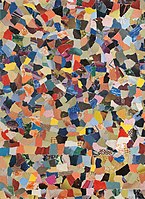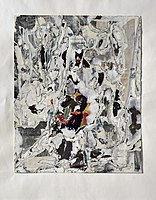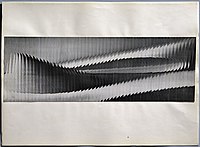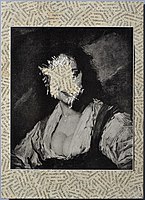Jiří Kolář
Jiří Kolář (born September 24, 1914 in Protivín , † August 11, 2002 in Prague ) was a Czech poet , visual artist and political activist .
Life
Youth and education
Jiří Kolář lived in Kladno most of the time . In 1932 he finished his apprenticeship as a carpenter and then worked as a baker's assistant, night watchman, waiter and then in Prague as an editor at the Dílo publishing house. He made his first collages in 1934, which were exhibited in the Prague Gallery D37 in 1937 and in the Mozarteum in 1938 . Almost at the same time he turned to literature with the support of František Halas . The first poems (Křestní list / Taufschein, Praha 1941) and translations from world literature such as TS Eliot's "Waste Land" as well as works by Carl Sandburg and, together with the art theorist Jiří Kotalík, Edgar Lee Masters are written .
Foundation of Group 42
In 1942 he was a co-founder of Skupina 42 , which also included the art theorist Jindřich Chalupecký and the writer Bohumil Hrabal . The red-lit steelworks in Kladno and the metropolitan civilization in Prague, which reflected the relationship between art and life, were also topics of the group members. Kolář depicted “Věže a sloupy” (Towers and Columns) in a collage in 1946. He adored the philosopher Ladislav Klíma , to whom he dedicated several works, such as the collage “Pro Ladislava Klímu”.
Moved to Prague and imprisoned
He joined the Communist Party in 1945 and left it in August. These political experiences shaped him retrospectively and always made him very critical of political circumstances. Kolář then moved to Prague and worked mainly as a freelance artist. Early on he was inspired by Max Ernst's surrealism and Dadaism by Kurt Schwitters , but also by poetism and Czech modernism. He dealt with Jindřich Štyrský , Toyen and Karel Teige . From 1946 to 1947 Jiří Kolář traveled through war-torn Germany to France. In Paris he visited the exhibition “The Art of Czechoslovakia 1938 to 1946” in the “La Boëtie” gallery. He then traveled to England and Scotland in 1948 . In 1949 he married Běla Helclová, whom he had met in Zlín in 1944 . As Běla Kolářová , she later became a well-known artist and photographer. From 1952 to 1953 he was imprisoned for his writing “Prometheova játra” (The Liver of Prometheus). In the mid-1950s, Jiří Kolář met every day in Café Slavia in Prague with artist friends and intellectuals such as Josef Hiršal , Kamil Lhoták , Ladislav Novák , Zdeněk Urbánek , Václav Havel , František Muzika and Jindřich Chalupecký. At meetings in Cafe Slavia, Kolář became a mentor for numerous younger colleagues.
Rehabilitation and development of various collage techniques in Prague
In 1963 he was legally rehabilitated and was co-founder of the group "Křižovatka" (crossroads) with his wife. After Kolář was mainly active as a writer in the 1950s, he began to turn to concrete poetry around 1959 and to express himself more visually and artistically. He exchanged the medium word for the medium picture. In 1952, analogous to his previous literary techniques, he designed collages like the confrontations “Dvě nitra” (Two souls), but also reports like “Krásný hon” (Beautiful Hunt) and anti-anatomies like “Kravička a housle” (Little cow and violin). In 1958 he created his found collage "Co starého v Evropě" (What is old in Europe). Kolář listed many other variants of his so-called Evident Poetry in his Methodological Dictionary (Slovník metod). Also scrolls such as “Božena Němcová” from 1959, circular scrolls (“Spící Venuše” / Sleeping Venus from 1964), typescripts (Fontana, 1961), illiteracy (“Analfabetogram Kresba” from 1962), knot poems (“Uzlová báseň” / knot poem , Assemblage 1963), hole, depth, color (“Barevná báseň” / color poetry, 1962), note and sign poetry as well as trace, blind, letter, hanging and razor blade poems. While working with the photographer Václav Chochola , about whom Kolář wrote a monograph in 1961, he created 20 rollages from 1960 to 1961, but also prollages with works by V. Chochola. After 1962 he further developed his collage techniques, such as through Magrittages, Chiasmagen 1965 (“Spirála” / Spirale, 1965), Relief Chiasmagen (“Pocta Delaunayovi” / Hommage à Delaunay, 1965), Muchlagen as well as Grumblagen (“Snící katedrála” / Dreaming Cathedral, 1964), décollages, valve layers, also fluttering collages and object collages (“Na počátku bylo slovo” / In the beginning was the word, 1969). In 1965 Helmut Heißenbüttel visited Kolář's studio in Prague. The contact to the Stuttgart group / school was established . He became an international member of this group of artists. He then conceived multiplied rollages (“Zvěstování” / Annunciation from 1966) and narrative zipp collages (“Vzpomínající leporelo” / Remembering Leporello, around 1965).
His hair collages from 1963 are to be understood as a reminder to the German concentration camps in World War II. In addition, the complex of so-called destatic poems (“Návod k použití” / instructions for use) is created. In 1967 he dealt with the Mec species that were exhibited in Osaka .
Prague spring
During the Prague Spring he documented a cycle of originally 67, now 66 collages in the “Diary 1968”, which are kept in the Neues Museum in Nuremberg . Kolář's collage diaries are weekly journals. Only in 1968, due to the political events in the ČSSR, had he made several collages a day, many of them in multiple layers, such as the "Collage of August 23, 1968". This diary is Kolář's political commentary on the political situation in the ČSSR. In the same year, Jiří Kolář made his international breakthrough. He exhibited at the documenta 4 in Kassel and in the Museum of Modern Art in Nuremberg . He became a member of the coordination committee of the Czechoslovak artists' associations . In 1969 he traveled to Brazil and was awarded a prize at the X Biennale in São Paulo . In 1970 Kolář suffered a stroke and could not move his right hand for over a year. In 1972 the cycle “Hommage à Baudelaire” was created.
Charter 77, artistic breakthrough and expatriation to France
In 1977 he signed Charter 77 and was banned from working in the ČSSR. He took part in Documenta 6 in Kassel in 1977. In 1979 he was a guest of the DAAD in Berlin for a year. During this time he visited Paris. After his scholarship was not extended, he stayed in France without the approval of the ČSSR authorities. In 1981 he founded the magazine "Revue Kolář" in Paris and has now worked with the Maeght-Lelong gallery. During this time countless works were created in which he quoted himself. Jiří Kolář was sentenced to one year imprisonment in absentia in 1982 and was also expatriated in absentia; his property as well as his important art collection were confiscated. His wife Běla was not allowed to leave the ČSSR for two years. In France, he received French citizenship in 1984.
Velvet Revolution and the last few years in Prague
After the Velvet Revolution in 1989, Kolář took part in the cultural life in the Czech Republic again. In 1990 he initiated the Jindřich Chalupecký Prize with Václav Havel and Theodor Pištěk . In 1997 Jiří Kolář returned to the Czech Republic and died in Prague after a long and serious illness.
Jiří Kolář was buried in a family grave in the Vinohrady cemetery in Prague. The Jiří Kolář Prize for Eminent Writers was named after him.
plant
Visual artist
Jiří Kolář became popular through the synthesis of various types of art such as poetry, collages, assemblages and objects. He dismantled words and images and put them back together again. Kolář worked with a wide variety of materials, mostly with image reproductions and text copies. The collage techniques invented and modified by Kolář enabled him to turn the starting material into a poetic instrument and to vary the potential for expression over and over again. With humor, but also irony, and with hidden criticism, Kolář put together his individual worldview. From the surrealist beginnings to Dada - his found collages quote Marcel Duchamp's Objets trouvés - he took up suggestions and integrated them into his own work. He also used ideas from Informel , Constructivism , Lettrism , kinetic and conceptual art. He worked with scissors and scalpel, with glue and the color-replacing printed paper. With this, Kolář brought a universal, linguistically unbound evidence of poetic expression into the visual arts through his newly created forms of collage. Jiří Kolář belonged to the group of the most influential and well-known Czech visual artists. His graphics, valued by collectors, are particularly popular in France.
Jiří Kolář, Hommage to Jan Palach (1968–1969), rollage and collage
Jiří Kolář, Lohengrin, comics (1964), collage
Literary man
His book Years in Days , written between 1947 and 1948, was published a year later. However, there is no longer a copy. The same thing happened with another work in 1970. Since then Kolář has been self-publishing.
His most important work were the poems Die Leber des Prometheus , published in 1979. It is a moral work that denies all forms of a totalitarian regime. The book consists of several independent parts.
In the Genor family (Rod Genorův) he takes texts by Ladislav Klíma and Zofia Nałkowska , forms them in verse and combines them into a story that is about a woman who was shot while fleeing in the war.
In poems of silence (Básně ticha) is visualized concrete poetry. In addition, he edited various publications.
Prices
- 1971: Gottfried von Herder Prize
- 1991: Order of Tomáš Garrigue Masaryk (2nd class)
- 1999: Hans-Theo-Richter-Prize of the Saxon Academy of the Arts
Art works in museums
- Berlinische Galerie Bruno, Berlin
- Moravská Gallery, Brussels
- MRBAB, Cambridge
- University of Kettle's Yard
- Art collection of the Veste, Coburg
- Museum of Art, Dallas
- Museum of Art, Dijon
- MBA, Erlangen
- Municipal Gallery, Gothenburg
- Art Museum, Helsinki
- Kiasma. Jerusalem
- Israeli Museum Cologne
- Museum Ludwig, Linz
- Lentos, Łódź
- MSZ Madrid
- Guggenheim New York, New York
- MMA Nuremberg
- City Collection Oldenburg
- Center Pompidou, Paris
- ČMVU, Prague
- Art Forum East German Gallery, Regensburg
- Museum of Samtidskunst, Roskilde
- Ulm Museum, Ulm
- Vancouver Museum, Vancouver
Exhibitions
- 1937 Gallery D37, Prague
- 1938 Mozarteum, Salzburg
- 1963 A. Jeffress Gallery, London
- 1964 Gravura Gallery, Lisbon
- 1965 SVU Mánes, Prague
- 1965 Small Gallery, Vienna
- 1966 Galerie ME Thelen, Essen
- 1966 Gallery H, Hanover
- 1967 Osaka
- 1967 Galerie Seyfried, Munich
- 1968 V. Špály Gallery, Prague
- 1968 4th documenta, Kassel
- 1969 Venice Biennale
- 1969 1969 Museum Kestner, Hanover
- 1969 Munich Art Association
- 1969 Künstlerhaus Nuremberg
- 1970 Gmurzynska Gallery, Aachen
- 1971 MAMVP, Paris
- 1972 Galleria Schwarz, Milan
- 1973 Lange House, Krefeld
- 1974 Guggenheim Museum, New York
- 1978 Museum of Modern Art, New York
- 1977 Modern Art Gallery, Zurich
- 1977 documenta 6, Kassel
- 1978 Guggenheim Museum, New York
- 1978 Albright-Knox Museum, Buffalo / NY
- 1979 J. Ricard Gallery, Nuremberg
- 1979 Center d'Art de Flaine, Paris
- 1980 Gunzenhauser Gallery, Munich
- 1980 New Berlin Art Association
- 1981 Maeght-Lelong Gallery, Paris
- 1981 Folkwang Museum, Essen
- 1981 Kassel Art Association
- 1982 Center Pompidou, Paris
- 1983 Galleria Zarathustra, Milan
- 1984 Gallery Schüppenhauer, Cologne
- 1985 Guggenheim Museum, New York
- 1986 Maeght-Lelong Gallery, Paris
- 1984 Künstlerhaus Nuremberg
- 1984 MMA, Oxford
- 1985 Hoesch Museum, Düren
- 1986 G.Insam Gallery, Vienna
- 1986 Maeght-Lelong Gallery, Paris
- 1987 House at Checkpoint Charlie, Berlin
- 1988 Museum of Culture and History, Osnabrück
- 1990 Albemarle Gallery, London
- 1990 SNG, Bratislava
- 1991 History Museum, Stockholm
- 1993 V. Špály Gallery, Prague
- 1993 Galleria Melesi, Lecco
- 1994 Galerie Schüppenhauer, Cologne
- 1994 ČMVU, Prague
- 1995 Anhalt painting gallery, Dessau
- 1995 CARS, Madrid
- 1997 Egon Schiele Centrum, Český Krumlov
- 1998 Palais Barbarini, Rome
- 1999 Graz, Kulturhaus Graz
- 2010 Galleria Melesi, Lecco
- 2010 GAMC, Bergamo
- 2012 Gallery V. Špály, Prague
- 1994 ČMVU, Prague
- 1997 GHMP, Prague
- 2001 E. Hilger Gallery, Vienna
- 2002 New Gallery, Linz
- 2003 Museum of Modern Art, Passau
- 2003 Kiasma, Helsinki
- 2007 Galerie Lelong: Addicted to paper, Zurich
- 2008 New Museum Nuremberg
- 2009 Kunstverein Augsburg: Collecting Collages, Augsburg
- 2012 Gallery Schüppenhauer, Cologne
- 2013 Art Forum Ostdeutsche Galerie , Regensburg
- 2018 Palais Goltz-Kinsky , Prague
Literary works
poetry
- Years in Days (Roky v dnech), 1949
- Baptismal sheet (Křestný list), 1941
- Seven cantatas (Sedm kantát), 1945
- Limb and other poems (Limb a jiné básně), 1946
- Odes and Variations (Ódy a variace), 1946
- Prometheus' liver (Prométheova játra), 1950
- Rod Genorův (The Genor Family)
- Poems of Silence (Básně ticha), 1960
- Accidental Witness (Náhodný svědek)
- Vršovický Ezop, written in the 1950s, published in 1993
- Up and down. Depth poem. Bong, Uelzen 1969
Diaries
- Days in the Year (Dny v roce), 1948. The poet's diary.
- Eyewitness (Očitý svědek), 1949
- Leap year (Přestupný rok)
Fine art books
- Methodical Dictionary (Slovník metod)
more books
- The black lyra (Černá lyra)
- Time (Čas)
- Hascheks Prague (Haškova Praha)
- King George's Thumb (Paleček krále Jiřího)
- Written on postcards (Psáno na pohlednice I.)
- The Wisdom of the Lord April (Napady pana Aprila, illustrated by Vladimír Fuka )
Essays
- Maybe nothing, maybe something (Snad nic, snad něco)
Children's books
- Kocourkov
Dramas
- This side of bread (Chléb náš vezdejší)
Translations
He has translated from English and French works by Walt Whitman , Thomas Stearns Eliot and Edgar Lee Masters .
Published in English
- Diary, 1968, David Elliott, Arsen Pohribny, State Mutual Book & Periodical Service, 1984, ISBN 0-905836-45-6
- Týdeník 1968 / Newsreel 1968, Torst, ISBN 80-85639-03-3
Illustrations
- Bohumil Hrabal: Dance lessons for adults and advanced . Suhrkamp, Frankfurt am Main 1997 (first edition 1967), ISBN 3-518-39265-4 .
literature
- Madla Vaculíková: Drahý pane Kolář. Arkýř & Mladá Fronta, Praha 1994, ISBN 80-204-0487-2 .
- Charlotta Kotik: Jiri Kolar Transformations. Buffalo Fine Arts / Albright-Knox Art Gallery, Buffalo NY 1978, ISBN 0-914782-19-3 .
- Thomas M. Messer: Kolar - Chiasmage. Selections from the Guggenheim. Katonah Gallery, Katonah NY 1988, ISBN 0-685-45726-5 .
- Astrid Winter: Metamorphoses of the Word. The media change in the work of Jiří Kolář. Wallstein, Göttingen 2006, ISBN 978-3-89244-972-0 . (At the same time dissertation at the University of Göttingen 2004).
- Daniela Uher: The Diary 1968. Jiří Kolář and the Prague Spring. 66 collages. FAU University Press, Erlangen 2017, ISBN 978-396147-019-8 . (At the same time dissertation at the FAU Erlangen-Nürnberg 2015).
Individual evidence
- ↑ The Herder Prizes awarded . In: Arbeiter-Zeitung , January 23, 1971, p 10, bottom right.
Web links
- Literature by and about Jiří Kolář in the catalog of the German National Library
- Jiri Kolar, Czech 1914–2002 on the Ubu Web (two examples: Brancusi (1966) and La poème evident (1967))
- Passau Media Center, exhibition October 14th to November 30th 1998 ( Memento from November 15th 2010 in the Internet Archive )
- Typoésie Museum
- Materials by and about Jiřì Kolář in the documenta archive
| personal data | |
|---|---|
| SURNAME | Kolář, Jiří |
| ALTERNATIVE NAMES | Jiri Kolar |
| BRIEF DESCRIPTION | Czech poet and visual artist |
| DATE OF BIRTH | September 24, 1914 |
| PLACE OF BIRTH | Protivín |
| DATE OF DEATH | August 11, 2002 |
| Place of death | Prague |
















